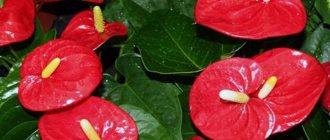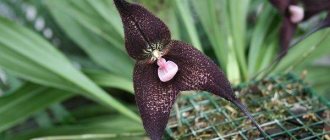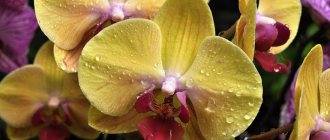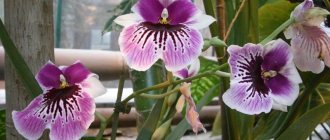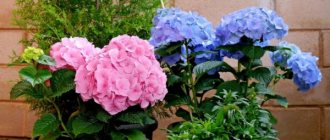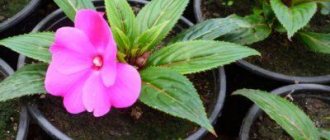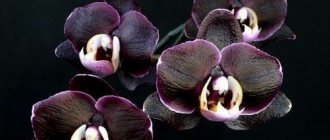Care after purchase
Ficus "Black Prince": care at home
When purchasing a plant, it is necessary to accurately determine the variety, since most suppliers often classify other varieties as it.
At home, the tree loses its natural ability to actively branch, but with proper care it can live for more than 40 years.
Watering
Watering is carried out with settled water as half of the top layer of the substrate dries.
Attention! Excessive moisture can lead to root rot and further death of the ficus elastica.
Bloom
The plant, as a rule, almost never blooms in any type of room.
In exceptional cases, ficus can please you with round fruits of yellow-green color, reaching a diameter of 1 cm.
Crown formation
- The formation of the crown of an already mature tree can occur in three ways:
- Pruning involves removing not only the top shoots, but also the nearby internodes (3-5 pieces).
- Fixing the trunk in a bent position, which will facilitate the replacement of a lateral bud with a dominant one.
- Puncture a tree trunk with a sterilized thick needle to 1/3 of its thickness in order to stimulate the emergence of new shoots.
Air temperature and humidity
The optimal air temperature for anthurium depends on the vegetative phase. During the period of active growth and flowering, the air temperature in the room should be between 20-25°C. The evergreen subshrub enters a dormant phase after a long flowering period, often lasting 10-12 weeks.
The epiphyte requires high air humidity and responds positively to year-round daily spraying with soft boiled water in the morning.
Features of home care
In order for these varieties to please with their healthy and beautiful appearance, it is necessary to provide them with careful care.
Temperature
This genus of flowers loves warmth. In the warm season, it feels good at temperatures of +20-25 degrees. In the autumn, the temperature is lowered to 12-15 degrees, thus the flowers are gradually transferred to wintering.
Important! It is necessary to ensure that cold air does not reach the bushes and that there are no drafts around
Lighting
Anthurium should not be kept in direct sunlight. To make him feel comfortable, he is placed on the window sills on the western or eastern side of the home. If this is not possible, then you can darken the window or move the flower during the day.
Watering
Adult plants are watered abundantly as the top part of the soil dries out; a young flower is watered more often. The average amount is 2-3 times a week. Water should be done without touching the plant with water (water on the buds can form brown spots), using warm, clean water.
Important! The remaining water from the pan must be poured out immediately
Humidity
These plants love humidity, especially during hot weather. At this time, they should be sprayed and given a warm shower. You can also place a vessel with water nearby to increase air humidity.
In addition to the above methods, to provide moisture for plants, they resort to covering the stems with moss, which are sprayed periodically. In addition, you can place flowerpots with bushes on a tray with wet gravel and expanded clay.
Priming
Ready-made primer compositions are available for sale.
Ready-made soil from the store has the optimal composition
But you can prepare the soil yourself; for this you need to mix the following ingredients:
- charcoal;
- coarse sand;
- pine bark (medium sized pieces);
- sphagnum moss;
- humus;
- leaf soil.
Take 1 part of each component. You also need to add drainage.
Feeding
The plant must be fertilized from March to September so that it pleases with its beautiful and healthy appearance. During this period, feed the plant once a week.
It is preferable to choose ready-made fertilizers:
- "Forte" includes magnesium and succinic acid.
- "Bona Forte" No. 1 or No. 2. It is a complex of mineral and organic fertilizers.
They are used for watering and spraying according to the instructions on the package.
You can also prepare the solution at home yourself. To do this, use one of the following recipes:
- a teaspoon of sodium sulfate per 2-3 liters of water;
- a teaspoon of “Agroschool for flowering plants” per 2 liters of water;
- 0.5 liters of fermented mullein per 10 liters of water.
It is worth watering with different fertilizers in turn.
Note! Sick flowers are not fed. After transplantation, feed them after 2 weeks.
Home care
Since anthurium is a plant from a tropical region, it requires appropriate living conditions.
Temperature
- Optimal temperature: 20–25°C.
- In winter, not lower than 16°C. At a temperature of 17–18°C, abundant spring flowering is stimulated.
- The pot must be at a sufficient distance from the radiator.
Anthuriums are afraid not so much of cold air as of drafts!
Watering and air humidity
The flower should be moistened with settled water at room temperature .
Watering should be done abundantly, once every 3-4 days, since anthurium is more afraid of overwatering than overdrying. The soil should have time to dry out between waterings. Be sure to empty the water from the pan to prevent rotting of the roots.
In spring it is necessary to spray the leaves daily. In the summer twice: in the morning and in the evening. The leaves should be periodically wiped with a soft cloth to better moisturize and remove accumulated dust.
Water should not get on the flowers.
If there is sufficient air humidity, drops may appear on the leaves . This is normal and not a disease.
To increase humidity, the pot with the plant can be placed on a tray with wet expanded clay.
Lighting
Since anthurium lives in the shade of spreading trees, it needs to be provided with diffused light at home.
- South window : direct rays can cause burns to the leaves, so the flower should be covered or moved deeper into the room.
- East or west window : sufficient lighting if the pot is close to the glass, but in case of direct rays, the anthurium must be covered.
- North window : here the plant will feel good, but there will not be enough light for abundant flowering. In this case, illumination with a fluorescent lamp is necessary.
Soil and pot
The soil should dry out quickly, since the Black Queen does not tolerate waterlogging.
Optimal parameters:
- fertile;
- slightly acidic (pH 5.0-6.0);
- loose and highly permeable to air and water.
Mixture option: 1:1:2-3 parts turf soil/river sand/leaf humus. You can also take leaf humus, peat and pine needles to ensure the desired level of acidity. It is recommended to add :
- coconut fiber;
- charcoal;
- pine bark (2-5 cm);
- chopped fern roots.
For greater looseness, add perlite or pieces of pumice/expanded clay.
You can always purchase a ready-made mixture for anthuriums in the store.
The root system of this plant is superficial, so it needs to be planted in a flat and wide pot.
Trimming
The lifespan of an anthurium at home is usually 10-12 years with good care. Gradually, the plant begins to look worse, so it is recommended to carry out a rejuvenation procedure (pruning).
Stages:
- Prepare a container: a 200-500 ml plastic cup with holes at the bottom, ⅓ filled with vermiculite.
- Cut off a cutting with aerial roots 11-16 cm long and remove all its leaves, leaving 2 pieces.
- Root the cuttings in a glass, sprinkling vermiculite on top.
- Moisten the soil and cover the entire structure on top with a bag or other light-transmitting material to ensure the desired level of humidity. The leaves must be sprayed with water.
- The improvised greenhouse should be kept in a warm (22–24°C) and bright place. Ventilate and spray the leaves with water daily.
- After 20–25 days, new roots appear. After the young leaves appear and the roots grow at least 3 centimeters, the plant should be transplanted into a permanent pot.
Feeding
The plant should be fed in spring and summer once every 2-3 weeks . The presence of large amounts of minerals and lime is unacceptable.
Leaf humus or not completely rotted cow or horse manure are very good as fertilizers.
Transfer
The frequency of transplants depends on the age of the plant. The young ones require it every year in spring or early summer. Adults, growing less quickly, once every 2-3 years. Transplanting an anthurium is no different from replanting any other indoor plant.
Transfer procedure:
- You need to prepare a flat and wide pot, the diameter of which is 1.5 times larger than the previous one. Expanded clay should be poured into it in a layer of 2 centimeters.
- Remove the plant from the old container along with the soil, and inspect the roots for rot and damage. Normally they should be whitish or light yellow. Unhealthy areas should be removed. If some of the roots have grown through the drainage holes, they can be broken off.
- Move the flower to a new pot, add the missing amount of soil and compact it until it is stable.
Video instructions for replanting a flower:
Wintering
For a favorable wintering, anthurium needs certain conditions.:
- There is no need to fertilize it between September and February.
- It is necessary to maintain humidity around 70%.
- The temperature is slightly lower than in summer, but not lower than 17°C.
- Watering is reduced to once a week; water stagnation is unacceptable.
Reproduction
There are several ways to propagate anthuriums:
- By seeds - this method is usually used for breeding, but at home it does not have much meaning, except to satisfy research interest.
- By division - the bush is divided into several parts in the rhizome area and each of them is capable of developing into an independent specimen.
- The third method was indicated above in the “Pruning” section : you can rejuvenate several cuttings and the base bush remains.
- Side shoots with aerial roots - they are separated and placed in a greenhouse until rooting.
How does black anthurium reproduce?
Propagation by cuttings and side stems is possible.
Cuttings
This method is simpler and includes the following steps:
- Side shoots with roots are separated.
- These shoots are transplanted into a separate container.
- The apical stems with 2-3 internodes are cut off for cuttings.
- In a wide container, the cuttings are deepened by 1 centimeter.
- The greenhouse is covered with film;
After a month, the bushes can be transplanted into pots.
Seeds
Propagation by seeds is more difficult. In addition, hybrid plants do not transfer their characteristics to the seeds.
Transplanting seeds includes the following steps:
- The seeds are soaked in a manganese solution. Germination can be carried out on damp foam rubber.
- Afterwards, the seeds are distributed on the surface of a moist substrate in greenhouse conditions.
- After a month, they are transferred to containers with water for germination.
All about reproduction
Anthuriums reproduce by seeds, cuttings, dividing the bush, aerial roots:
- It makes no sense to grow Black Queen from seeds, because hybrids do not transfer the properties of their parents. But you can get new varieties. But first they pollinate the plants and wait for the fruits to form and ripen. Collect seeds and immediately prepare them for sowing. First, soak for 2 hours in a pink solution of potassium permanganate. Place a layer of foam rubber on the bottom of the dish and moisten it. Seeds are placed on top. Cover it with glass, creating a greenhouse. Sprouted seeds are sown in loose soil, compacted, and sprinkled. covered with glass. When they grow to 7 cm, they are transplanted into new pots.
- For propagation by division, several stems are separated during transplantation and replanted separately.
- To propagate by cuttings, cut off the top of one or more stems, prepare a mixture of peat and sand, and plant the cuttings there. Cover with a glass jar. Water periodically. Remove the jar after the first young leaves appear. The first days, cover for several hours until the plant gets used to it.
- For propagation by layering, roots are taken that are closer to the soil surface. They are separated and planted in a new container.
Description of types of black anthuriums
There are several varieties of black anthurium. Next we will talk about the main ones, their features and distinctive features.
Black Queen
Anthurium Black Queen differs only in appearance; the bract and spathe are black and have a bright red tint. And when the buds begin to open, the buds take on a cherry tint, but everything else remains black with a red tint. The leaves of a flower called Anthurium Black Prince always remain green no matter what.
A black hybrid seedling that has retained many features, so you can often find multi-colored roses on one bush. They come in either completely black or red. This combination creates a beautiful view of the entire garden plot. However, not every gardener likes this flower, the reason for this is that it looks too mournful, but there are many flower lovers who are madly in love with this extraordinary specimen.
Black Love
Anthurium Andrianum Black Love is a hybrid belonging to the group of plants of the Love variety. The evergreen shrub grows up to half a meter in height. The foliage is glossy, dark green, and has no inclusions. The flower spadix grows straight and is light beige or yellow in color. Its color changes as it ripens, and after a while it becomes the same shade as the bedspreads.
Peduncles grow in a vertical position. The blanket grows up to 15 centimeters in diameter. It is heart-shaped and black and burgundy in color.
Black Beauty
This variety is quite rare even among the most experienced gardeners. Black Beauty is very similar to its brothers, only the shape of the bedspread is different - it looks like a tulip. When grown at home, it grows up to 65 centimeters in height. The foliage is velvety and green. On the other side of the plate, the leaf has veins colored burgundy. The cob grows straight, in an upright position.
When the bud ripens, the black color begins to merge with a burgundy tint. The bush is lush, and with proper care, two or more growth points are formed on it.
Black Dragon
Black Dragon is a variety of larger varieties of Anthurium. The difference lies in the decorative nature of the black inflorescences, as well as in the color of the leaves. Lanceolate leaves grow on small petioles, giving the bush lushness. The leaf blade is variegated in color and changes from green to burgundy inclusions and veins.
This flower attracts attention not only with its shape, but also with its rather voluminous leaves. After some time, the cob turns brown. And at the peak of flowering, the cob changes color to a yellow-brown hue
The bedspread has an elongated shape
And at the peak of flowering, the cob changes color to a yellow-brown hue. The bedspread has an elongated shape.
Chocolate Love
The shrub grows to medium size and belongs to the decorative group of plants. At home, the size is no more than half a meter in height. This variety is rarely found among amateurs and experienced gardeners. The foliage is green. Heart-shaped leaf plate. On the other hand, the leaves are velvety, the veins are almost invisible. The ear of the flower is also green, only lighter, but darkens during the flowering of the seedling. The diameter of the bedspread is 11 centimeters. With proper care, the bush grows lush and very beautiful.
Anthurium transplant
From time to time, anthurium needs to be replanted. But this is often not worth doing. Especially do not suddenly increase the size of the pot. In this case, the root system grows quickly, leaves actively grow, but flower stalks do not appear. Anthurium is transplanted for the first time shortly after transplantation. First, give the plant 2 weeks to adapt to new conditions.
The pot for growing Black Queen anthurium is wide but low.
This will restrain the growth of the root system and allow flower stalks to form. Sometimes the roots after replanting end up at soil level. In this case, cover them with damp sphagnum moss. It will protect them from drying out.
Turn the pot on its side, tap the walls and remove the plant. They examine its roots. If there are any damaged or rotten ones, remove them and sprinkle the cut areas with crushed charcoal. Place the plant in a pot and cover it with soil at the same level as before transplanting. Water with warm water. When there are a lot of plants, you can plant several plants in one pot. This will make the bush more lush and the number of flowers will increase.
Features of care
Black anthurium requires the same care as any other variety of this crop. If a plant grows and develops poorly, you can see characteristic signs on it that indicate one or another disorder. For example, if the leaves of an anthurium have turned yellow, it most likely does not have enough light. The watering rules may have been violated. Any changes on the surface of the plant may also indicate an insufficient supply of essential nutrients. In this case, it is necessary to apply fertilizer.
Spots on flowers appear due to violations of watering rules. It is recommended to water the plant at the root, and when irrigating, avoid getting water on the flower stalks.
Watering rules
Anthurium is watered once a week. But watering should be plentiful. If the plant has bloomed, moisturize up to 3 times a week.
In summer, during hot and dry weather, the plant is sprayed. Avoid getting water on the flowers. The water must be settled. Also during this period or while heating the apartment, it is recommended to place an open container with water near the plant.
Temperature readings
Anthurium loves warmth. Therefore, the optimal temperature for its high-quality growth is +20 - +25 degrees. If the air temperature is below +15 degrees, the plant may stop developing. Lower temperatures lead to the death of the crop.
Lighting
The flower does not like to be exposed to direct sunlight. Therefore, it is recommended to choose shade for the plant. It is strictly forbidden to place anthurium on a windowsill.
Top dressing
The plant requires fertile soil. It is necessary to add peat and wood ash to the soil; you can purchase special soil in stores specifically for these plants.
Flower feeding is carried out twice a month. They use not only organic, but also mineral fertilizers. The first feeding is carried out when young leaves begin to appear en masse on the plant. The plant is fed a second time when buds appear.
Diseases and pests
The most common problems and ways to solve them:
- Leaves curl - excess light, the plant should be shaded.
- Does not bloom - lack of light, additional lighting is needed.
- Dark spots on flowers are due to water droplets. Great care must be taken when spraying.
- Rotting of the stem - waterlogging. Reduce watering.
- Spotted leaves and flowers - fungal damage. The diseased parts are removed, the rest is treated with a fungicide solution.
- Roots with knots and slow growth - damage by root nematodes. To destroy pests, the roots of the plant are immersed in water at a temperature of 50°C for 10 minutes.
Common Pests for Houseplants:
- thrips;
- scale insects;
- spider mites;
- aphids.
Description of types of black anthuriums
Anthuriums with a black veil appeared thanks to the efforts of breeders. In the initial phase of flowering, the bract often has a dark burgundy color. The cover darkens as the cob ripens, which gives the indoor plant even more decorative.
Black queen
Black queen or black prince is a tall species. Another transcription of the name anthurium “black queen” is often found.
The height of an adult specimen often reaches 80 centimeters. The erect ear at the beginning of flowering is white or light beige.
The light vertical cob favorably emphasizes the dark color of the bedspread. The size of the dark blanket ranges from 12 to 15 centimeters in diameter and depends on the age of the plant and growing conditions. The glossy, heart-shaped bract has raised, pronounced veins, which further emphasize the unusual appearance of the hybrid.
In the initial phase of flowering, when the ear is still smooth, the spathe has a dark burgundy or cherry color. Over time, the bract becomes darker, reaching a black tint with a reddish tint by the time the small inflorescences of the vertical cob open.
The green leaves of the black queen hybrid are dark green, leathery, elongated, heart-shaped. Petioles are vertical, straight. Peduncles grow from the axils of the leaves. Erect arrows rise above the greenery of the subshrub.
Black love
The full name of the hybrid is Anthurium Andrianum Black love. The plant belongs to the numerous line of love hybrids.
The elongated glossy leaves of black lavas are dark green in color without any inclusions. The spadix flower is erect, light beige with a greenish or yellow tint. The color of the cob becomes darker as it ripens, almost completely merging with the color of the spathe.
Vertical flower stalks rise above the greenery of the epiphyte. The size of the bedspread reaches 15 centimeters in diameter. The bedspreads are elongated, heart-shaped, black with a burgundy tint. The texture is not pronounced, the surface of the bract is almost smooth.
Black Beauty
The black anthurium variety differs from its counterparts in the decorative nature of its green foliage and tulip-shaped cover.
The decorative flowering epiphyte at home reaches 65 centimeters in height. leaves with a slightly velvety surface have a rich green color. On the reverse surface of the leaf blade there are pronounced burgundy veins.
The ear of “black beauty” is straight and vertical. In the ripening phase, it is colored black and blends into the background of the bedspread.
The bract has an elongated tulip-shaped shape. It reaches ten centimeters in diameter. The color varies from dark burgundy at the beginning of flowering to black with a burgundy tint in the ripening phase.
With proper care, Anthurium Black Beauty forms several growth points, giving the bush fullness.
Black Dragon
This species is extremely rare in gardeners' collections. The exotic “black dragon” belongs to the line of large anthuriums. The plant is distinguished not only by the decorativeness of its black flowers, but also by the unusual color of its greenery.
Elongated lanceolate leaves grow on short petioles, forming a lush herbaceous bush. The variegated color of the leaf blade changes over time from a green palette of varying intensity to pronounced burgundy inclusions and veins.
The color of the tall cob tends to brown tones. The color of the ear changes to yellow-brown as the peak flowering phase approaches. The brown spathe or bract is not sufficiently expressed and has an elongated shape.
Chocolate Love
Decorative flowering evergreen subshrub Chocolate Love reaches a height of 50 cm at home.
Flower growers often call this species chocolate anthurium or chocolate love. The leaves are glossy, leathery on long stalks. The shape of the leaf plate is elongated heart-shaped. The underside of the leaves is matte, slightly velvety. Veins are not expressed. The color of the glossy side is rich green.
The vertical upright ear of the chocolate love anthurium is colored light green, darkening as it blooms. The bract or spathe is heart-shaped with raised edges and a sharp tip and has a glossy surface. The relief texture emphasizes the arrangement of veins.
The blanket reaches 9-11 centimeters in diameter. Vertical arrows of peduncles rise above the green leaves. In favorable conditions, the plant forms many growing points, providing the dense greenery of a herbaceous subshrub.
Description of varieties
Perhaps one of the most beautiful and unusual varieties of anthurium is the Black Queen variety.
It belongs to the green-leaved group and is a hybrid. Due to its unusual coloring, the flower is also called the Black Prince. The plant has all the characteristics of the parent varieties: the anthurium cob is yellow-green, but the spathe itself on the flowers of one bush can be either the same color or of different colors. During the budding phase, a rich cherry color predominates, but when the spathe is fully opened, it turns black with a dark red tint. However, there are anthuriums that can have flowers with both black and cherry stipules on one plant.
Black or red covers on anthurium cobs are in perfect harmony with dark leaves, which have a glossy sheen and are painted with lighter veins.
Connoisseurs of exotic plants try to get Black Queen into their collection, although some gardeners prefer to avoid it due to its almost mournful coloring.
Like all anthuriums, Black Queen needs careful care, in which the bush will not only grow well, but also bloom abundantly. To do this, you need to provide him with:
- Diffused lighting. The southern room is suitable for the plant only in winter, and it is advisable to place the pot not on the windowsill itself, but on a stand or cabinet by the window. The rest of the year, anthurium should live in the east or west; direct sunlight is harmful to it.
- Watering and spraying. In winter, it is enough to water the anthurium once a week, with the arrival of spring - double the frequency, not allowing the water to stagnate in the pot and tray. Anthurium loves showering and spraying, but only on the leaves, without affecting the inflorescences. You can wipe the leaves with a damp sponge.
- Comfortable temperature. Do not allow the temperature to rise above 25 degrees in summer, and do not allow it to drop below 12 degrees in winter.
- Periodic feeding. It is especially important to fertilize the Black Prince with complex preparations during the formation of inflorescences.
Every two years, the anthurium needs to be transplanted into new nutritious soil, but the pot should not be too large. Of course, the flower will grow in it, growing roots and foliage, but flowering will not occur until the root system fills the entire flowerpot.
Dark green leaves serve as a kind of health indicator for the flower. At the first signs of a change in their color, you should immediately take measures to save the anthurium:
- yellowing of leaves - lack of light, improper watering or lack of nutrients;
- light or brown spots - from the cold;
- black spots – excess calcium in the soil.
Stains on the bedspread indicate that droplets of water got on them during spraying.
Red anthurium - a flower from an old legend
A bright glossy blanket and a yellow spadix consisting of many tiny flowers. This is what a classic anthurium looks like, the legend of its origin has been remembered for many centuries in South America.
On this topic:
BACK
FORWARD
1 of 8
The young beauty sacrificed her own life in the name of love and fidelity. Amazed by such selflessness, the gods turned the unfortunate woman into a scarlet flower with a single petal in the shape of a girl’s heart.
Red anthuriums are still considered classics today and are highly valued among gardeners.
Anthurium Dakota can rightfully be called the most famous and widespread variety. At the same time, the plant stands out not only with the rich color of the bedspread, but also with its size from 14 to 23 cm. A large, spectacular plant cannot be ignored even in a very spacious room.
The name Anthurium comes from Anthos - flower, and Oura - tail. But no less than the tail, the cob resembles the long neck of a flamingo. But unlike flamingos, anthurium today can have more than just red or pink colors.
Anthurium inflorescences of the Minnesota variety stand out from a number of equally spectacular plants with bright scarlet bracts and cobs that change color first from white to yellow and then to green.
The group of Red anthuriums, with the predominant color of the cover being red, is very large and diverse. This also includes Anthurium Edison, which is presented on store shelves not only with plants with red inflorescences, but also with varieties that bloom in pink tones.
In addition to scarlet and classic red varieties, you can find Dark Red Anthurium. The bracts of such anthuriums, as in the photo, come in all shades from crimson, wine to burgundy, brown or almost black.
An example of a brown anthurium is the Otazu Brown variety with a deep burgundy heart-shaped spathe and a straight light green cob.
Anthurium varieties Utah readily form solemn large inflorescences with a glossy textured blanket with a diameter of up to 14 cm. The spadix and bracts of anthurium are violet or deep purple. At the same time, older inflorescences can be easily identified by the green tint at the base of the bedspread.
Luxurious black anthurium Black queen appears even darker thanks to the light color of the cob. On the surface of the dense, glossy bract, all the veins stand out in relief, giving the inflorescence a simply fantastic look.
Botanical description and history
Anthurium black (anthurium Black Prince, Black Queen) is one of the hybrid species of the genus Anthurium of the Araceae family, which has more than 800 species. This plant is also called “male happiness” or “flamingo flower” for its large flowers with dense cob.
The Austrian biologist Schott first created the classification of the Anthurium genus back in the 19th century. In the 20th century, the German botanist Engler supplemented this classification with several species, and in 1983 the genus was divided into 19 separate classes by the Croatian scientist Schaeffer.
In nature, this flower is found in mountainous and rocky areas and grows in the tropical forests of America, Colombia and Ecuador.
The flower is a perennial, belongs to the tall varieties of anthurium, the bush of the plant grows 70-80 cm in height. The flower itself consists of a spadix and a large, smooth single petal - the so-called spathe. At the very beginning of flowering, the flower ear is light beige in color, and then gradually turns green.
The blanket is smooth, shiny, heart-shaped, reaches 12-15 cm in length, and has a pattern in the form of veins. At the beginning of flowering, the bedspread has a cherry tint, which darkens over time and becomes dark burgundy, almost black. The leaves are smooth, dark green, elongated, like the buds, heart-shaped, reaching up to 30 cm in length. The petioles are straight.
Andreanum
The Andreanum variety, or Andre for short, is considered one of the most popular and accessible of other varieties. This epiphyte is native to Southwestern Colombia and Northwestern Ecuador.
Distinctive features of the plant:
- andreanum boasts dark green leaves with a heart-shaped base;
- the color of the bedspread is deep scarlet;
- the flowers are unremarkable, pale yellow and collected in a small spadix (10 cm in length);
- The length of the leaves reaches about 30 cm, the width is about 12 cm;
- After flowering, round, orange fruits are formed.
Anthurium andreanum is popular among breeders. There are several varieties of it:
- Belize is distinguished by yellow inflorescences and dark red bracts.
- Dakota is known for its scarlet “spread” and triangular, slightly pointed green leaves.
- The favorite has a lavender inflorescence with a pink bract. The stem of this plant is tall, strong, the color of the leaves is dark green.
- Leganza is distinguished by its orange flowers and oval-shaped leaves, slightly pointed at the edges. The bract is coral-colored and has green edges.
- Otazu has a yellow inflorescence and a dark red bract.
Each variety is characterized by different growth rates, and the duration of flowering can vary from 1 month. up to 1 year. Therefore, when purchasing Andreanum, first familiarize yourself with its features.
You can see what the Anthurium Andreanum variety looks like in the photo below:
When and how does it bloom
Anthurium - types and varieties of plants with names
If the plant is well cared for, it can bloom regularly, usually from March to November. By winter it goes into hibernation.
The flowering of the innerium looks unusual
The bud can grow from the center of the shoot, from the side. At first it looks like an arrow, different in color from the leaves. The flower will take a long time to grow. The next stage is opening: the pistil is shown, and after a few days the bud opens completely.
Interesting! The flower remains in its original form for up to 2 months; after this period, the shade will become paler and it will dry out.
Rules for caring for black Anthuriums
Before purchasing a seedling, you need to inquire about how to properly care for a flower at home. Almost all varieties of Anthurium have been equated to capricious and easily vulnerable plants grown at home. The agricultural technology of these plants is the same as that of many representatives growing in the tropics. Therefore, conditions should be as close to the tropics as possible.
The most common factors that have a bad effect on flower health are:
- Dry air.
- Bad light.
- Over or under watering.
Experienced gardeners under no circumstances recommend that beginners start growing flowers with Anthurium black, because the plant is vulnerable and can die from the slightest error in care.
The most suitable temperature for a flower is 25 degrees, this is especially important at the time of flowering and growth. After the flower fades, it rests for several weeks. At this moment, the temperature in the room should be about 18 degrees, but if it is lower, it can be fatal for the flower
In order to increase the humidity in the home, the epiphyte must be sprinkled with water, this should be done in the morning
At this moment, the temperature in the room should be about 18 degrees, but if it is lower, it can be fatal for the flower. In order to increase the humidity in the home, the epiphyte must be sprinkled with water, this should be done in the morning.
When Anthurium grows in a natural environment, the plant does not encounter direct sunlight only because it grows in the shade that is formed by tall and voluminous trees. When growing at home, the flower should be placed on a windowsill located in the south or east. For additional lighting, you can purchase a lamp in special stores. The plant should be exposed to light no more than 10 hours a day.
The disadvantage of Anthuriums is that they cannot accumulate and store moisture. The main thing is to prevent drying out and excessive accumulation of water. Anthurium needs to be watered 1-2 times every seven days, especially if at this moment it is actively growing and developing.
In addition, the flower is fertilized several times a month with substances for flowering plants. However, when preparing the solution, the dosage should be less than indicated on the fertilizer packaging. After flowering, Anthurium can be watered once a week. At this moment, the plant will be resting, which means it does not need fertilizing, otherwise its use may lead to the development and growth of new shoots. Violation of the dormant phase of a seedling can affect the number of inflorescences during flowering.
During care, many gardeners and hobbyists make many mistakes. Some simply do not have sufficient information about the flower, while others, at their own discretion, try to improve the conditions of the flower, but only harm it. The most common mistakes leading to the death of a bush are:
- Overdrying of the soil or excessive waterlogging.
- Frequent feeding with fertilizers.
- Exposure to direct sunlight for a long time.
- Rooting cuttings in an aqueous solution.
- Low air temperature in winter, leading to hypothermia.
- Temperature fluctuations.
In order to grow Anthurium black, you should familiarize yourself with the rules for caring for epiphytic plants and then strictly follow the instructions and recommendations. Only in this case the result will be positive, and your flowers will be admired by everyone who sees this miracle.
Anthurium “black queen” home care:
Problems during cultivation
When growing Black Queen anthurium, you need to carefully monitor its condition. Most often they suffer from the following factors:
- High indoor humidity.
- Incorrect temperature.
- Poorly chosen place for a flower.
- Frequent watering.
Any problems are reflected in the appearance and condition of leaves and flowers:
- Leaves turn yellow due to improper watering or insufficient lighting.
- White spots appear on the leaves when the plant is kept at low temperatures. You can get rid of them by moving the pot with the plant to a warm place.
- If brown spots appear, also move the pot with the plant to a warm place and reduce the number of waterings and the volume of water applied.
More information can be found in the video:


